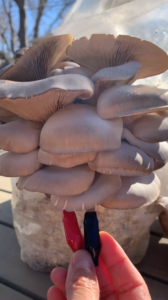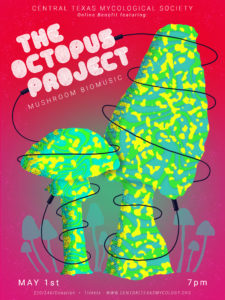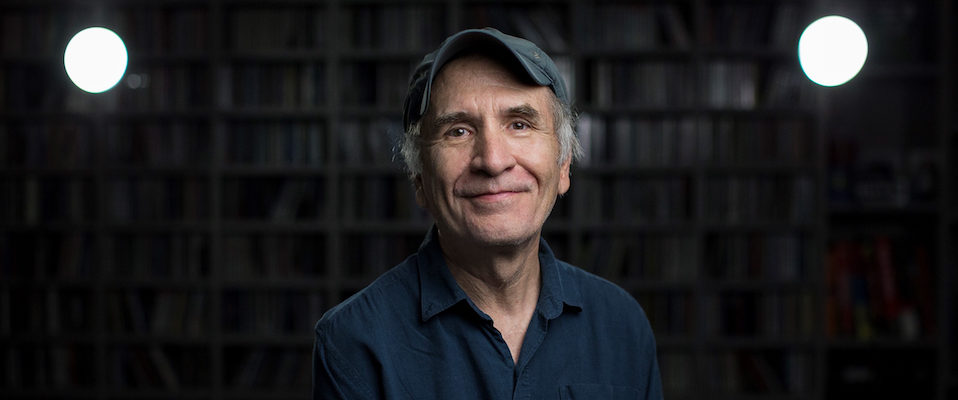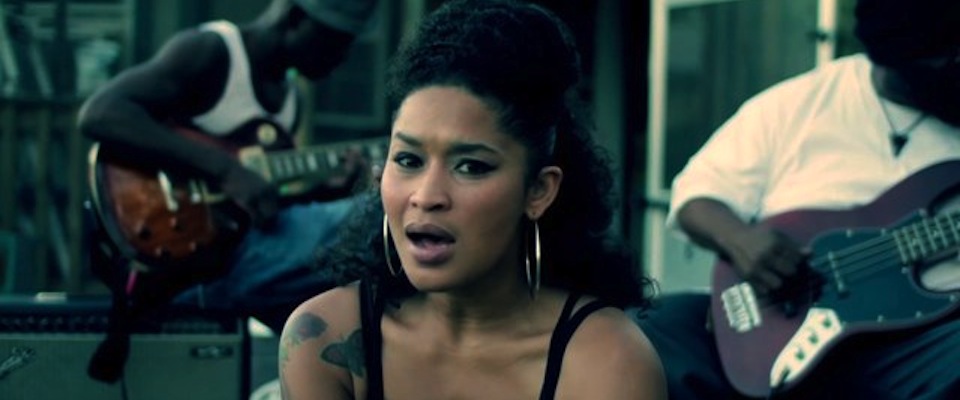photos and video courtesy of The Octopus Project
By Art Levy
Every living thing gives off electricity. It’s a fact that shouldn’t be buried in boring textbooks but displayed in gigantic, neon letters at the front of the classroom. When you learn that “every living thing gives off electricity,” it leaves you in awe, and your mind starts to make interesting connections, spreading like mycelium. Soon the next question arrives. “Cool. Then can mushrooms make music?”
 That’s the thinking behind one of the more unique concerts you’re able to see from the comfort of your couch. On May 1, Austin electronic group the Octopus Project hosts a livestream and benefit for the Central Texas Mycological Society that features music and visuals essentially “played” by mushrooms, followed by a Q&A on this fascinating process. (And just to be clear: a mushroom is not a plant. It’s a fungus, a separate biological kingdom more closely related to humans than to plants).
That’s the thinking behind one of the more unique concerts you’re able to see from the comfort of your couch. On May 1, Austin electronic group the Octopus Project hosts a livestream and benefit for the Central Texas Mycological Society that features music and visuals essentially “played” by mushrooms, followed by a Q&A on this fascinating process. (And just to be clear: a mushroom is not a plant. It’s a fungus, a separate biological kingdom more closely related to humans than to plants).
Nature has inspired musicians for centuries, but recent history has proven to be a particularly fertile time. Experimental composer John Cage was a dedicated amateur mycologist, going so far as to publish a book of recipes, photos, and essays about the musicality of mushrooms in 1972. There’s also Mother Earth’s Plantasia, a 1976 album of childlike synthesizer music by Mort Garson that somewhat dubiously claimed to help your plants grow. And Stevie Wonder capped off the 1970s (and his chart-topping run of albums) with Journey Through The Secret Life Of Plants, a documentary soundtrack featuring ninety minutes of bizarre, electro-funk plant worship, all from the man who brought you “Sir Duke.”
 But in 2021, musicians aren’t content with merely playing for plants—they’re playing with plants. The Octopus Project is no stranger to taking wonderful, science-adjacent ideas like these and running with them. The band—Yvonne Lambert, Josh Lambert, Toto Miranda, and Mari Rubio—is known for its wildly-creative live shows, like those for the 2010 album Hexadecagon, which featured eight loudspeakers surrounding the members while eight projectors showed videos synced to the music.
But in 2021, musicians aren’t content with merely playing for plants—they’re playing with plants. The Octopus Project is no stranger to taking wonderful, science-adjacent ideas like these and running with them. The band—Yvonne Lambert, Josh Lambert, Toto Miranda, and Mari Rubio—is known for its wildly-creative live shows, like those for the 2010 album Hexadecagon, which featured eight loudspeakers surrounding the members while eight projectors showed videos synced to the music.
Like a fungal network, the band’s interest in mushrooms doesn’t have a definitive starting point, but the project first started sprouting in Peru in 2019. There, Yvonne and Josh met a friend who had a MIDI biodata sonification device, which measures electrical fluctuations through sensors attached directly to any living thing—plant, fungus, or otherwise. That data is then translated into MIDI notes, which can be played by a synthesizer or computer software. They drove around the Sacred Valley, home to Machu Picchu, and started testing the device on various plants, amazed at the possibilities opening before their ears. Yvonne and Josh quickly bought a sonification device as soon as they got back to Austin, and the process of playing music with mushrooms has been inspiring. “The sky’s the limit with this,” says Josh. “There’s a ton of stuff that can be mined from this idea.”
KUTX: How did the idea of playing music with mushrooms first come about?
Yvonne: In Peru, we had been focusing on plants and we just happened upon this random kind of garden mushroom and decided to try to record that. [We] noticed a huge difference between the biodata that we picked up from the mushroom versus the plants. The mushroom gave off a much more dense signal of this constant information. [When turned into MIDI notes] it sounded like a mad scientist playing a pipe organ, compared to a eucalyptus tree we recorded that played one note and then five to 10 seconds of silence and then that same note again—this kind of minimal pulse of sound. This mushroom was like an explosion of sounds.
Being in quarantine [this past year], I joined the Central Texas Mycological Society just to go on some mushroom hikes and learn more about mushrooms and hopefully gain access to much more mushrooms to record. I think initially I was going to do a mushroom hike where we recorded mushrooms, live and in person. And with lockdown getting more serious last December, we decided to try something a little different and do a Zoom kind of performance.
KUTX: How does this MIDI biodata sonification device work?
Josh: Anything that’s alive is giving off internal electrical impulses. And [the device] is registering the different impulses that each [living] being has and then translating it into MIDI data, which we bring into the computer and then assign whatever kind of sound we want or key or whatever. We design what it sounds like.
Yvonne: For this performance, we’re actually using the MIDI data from the mushrooms to control [both] the music and the video.
Josh: One really cool thing is that, when the MIDI data changes, [the video] can change. We’ll set up the parameters, but [the mushroom] can make things bigger or smaller or change colors or shape or whatever. And it does do it over time, so it does change constantly. It’s pretty interesting.
Toto: We’re also providing it with live input, like Josh will be changing the sound, or Yvonne will be playing another instrument on top, or I’ll be adjusting the video live. So [the performance] has both input from the plant data source and our live input kind of as a feedback loop, I guess, if the plant is listening [laughs]. Both human and plant data [are] controlling what you see and hear.
KUTX: I take it different types of mushrooms are going to “sound” different, right?
Yvonne: Yeah, their data and variations will be different.
Josh: You can also kind of customize it. This mushroom physically looks like this, so maybe it sounds like this kind of thing to me. What does it feel like for that mushroom to be?
Yvonne: In the past we’ve had these big trumpet mushrooms and it seemed kind of funny to assign them these horn sounds. [laughs]
Josh: It sounds cool and sometimes [it sounds] stupid. [laughs]
KUTX: How does it feel as musicians to work with a non-human collaborator?
Toto: We’ve done ambient stuff kind of like this before, like trying to set up an atmosphere. And this just feels like there’s another hand in the process that is something to respond to.
Yvonne: I think plants make excellent ambient music. [laughs] It feels like a true collaboration in this way of just making ambient music.
Josh: It’s either ambient or like totally crazy sounding. [laughs]
KUTX: I can imagine that can be both frustrating but also really exciting as a musician, allowing the mushroom to dictate where the performance goes. What is that experience like?
Josh: We’re not necessarily in control, which feels cool. And ideas or sounds or rhythms that we wouldn’t necessarily have come up with on our own come out, and so it feels kind of exciting every time. But I don’t know what it’s going to sound like—I mean, within parameters—but I just literally have no idea what it’s going to be. It’s like free jazz or something, you know. It’s just like improvising.
KUTX: Right. So each performance is totally unique.
Toto: Yeah. The way we’ve been approaching this show is kind of having a different sort of sound and visual environment for each of five or six types of mushrooms. So Josh and Yvonne have been kind of developing a sound for it, and then I’ve been developing a visual. I’ll get something that I think is working pretty well visually, based on the kind of input I think we’re going to be getting from the mushroom. But then a lot of times we’ll set it up and the mushroom is just not doing what I expected at all. [laughs] So I have to go back to the drawing board like, “OK, well, do you like this one?” [laughs] It’s like having a client—you have to meet their demands.
KUTX: Or like a grumpy band member. [laughs]
Toto: Yeah. “I made this cool thing for you, why don’t you want to play with me?”
KUTX: Where did you get the mushrooms?
Josh: Well, right now, just for testing, we’ve just been buying them at the store.
Yvonne: Wheatsville, Central Market. Asian markets like H Mart and 99 Ranch have some pretty big mushrooms—big, unusual ones. So Asian markets are a really great resource and then the Central Texas Mycological Society have given us some. [And Smallhold], which is a company here in town, they’re going to be giving us some mushrooms for us to play for the performance as well.
KUTX: Has this experience changed your perception of the natural world?
Josh: I guess we’re always [aware] that everything is alive and then this is kind of like a visual and audio representation of it—this is proof. This thing is speaking to you in this way. You’re seeing and hearing it. It makes you feel a lot more connected to everything.
Yvonne: I’ve always loved plants, and going to Peru was another kind of step in learning about plants. And I’ve always talked to my plants and felt a closeness with my plants, but I do feel like this music box has kind of opened up a whole new world of connecting with the plants in general.
KUTX: I’m excited to see this in action. Anything else you want to say about the performance?
Toto: [During the show] I’ll be running the visual system, which inevitably involves continuing to tinker with the way the network is set up, and it already has this kind of like science lab look to it. It’s a visual programing system with nodes that connect with wires, which is super fun and looks really complicated. [laughs]
KUTX: And correct me if I’m wrong, that’s kind of similar to how a fungal network can work, right?
Toto: Yeah. The aesthetic works with that and is, you know, also about connections. It’s all about connections.



